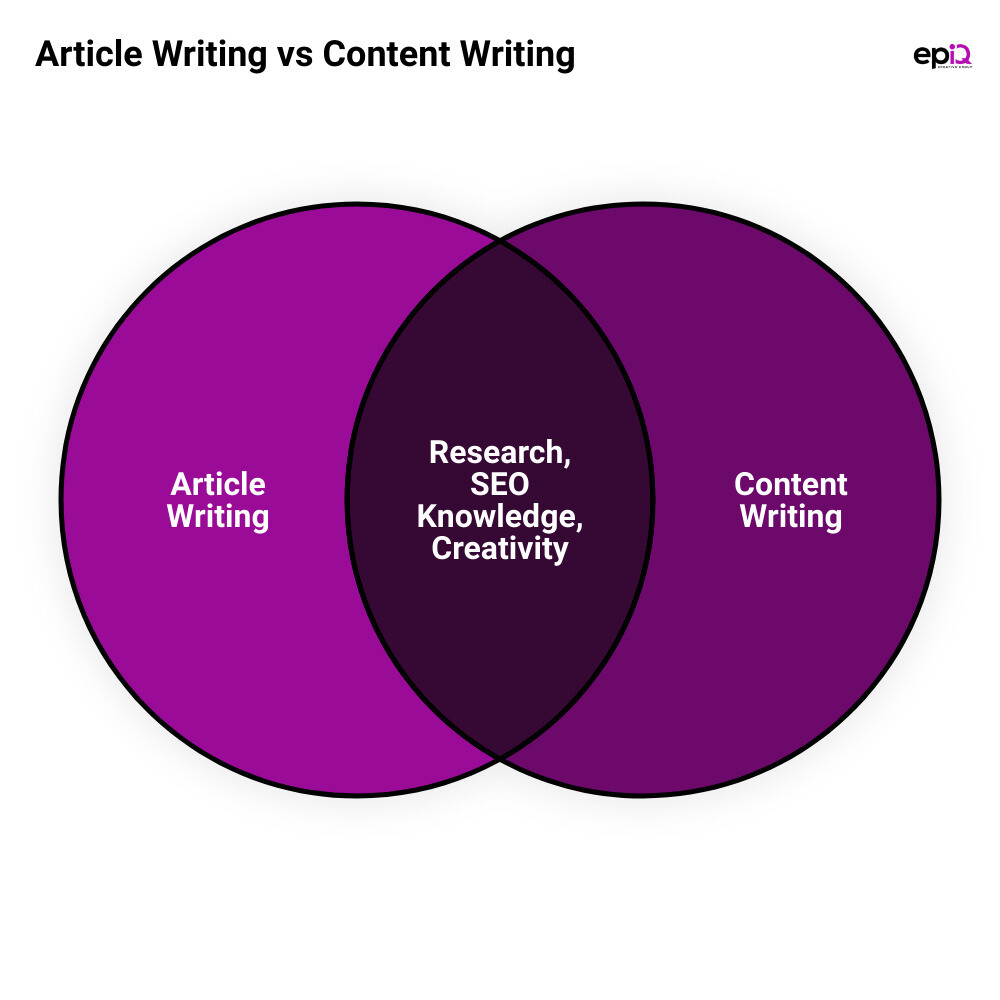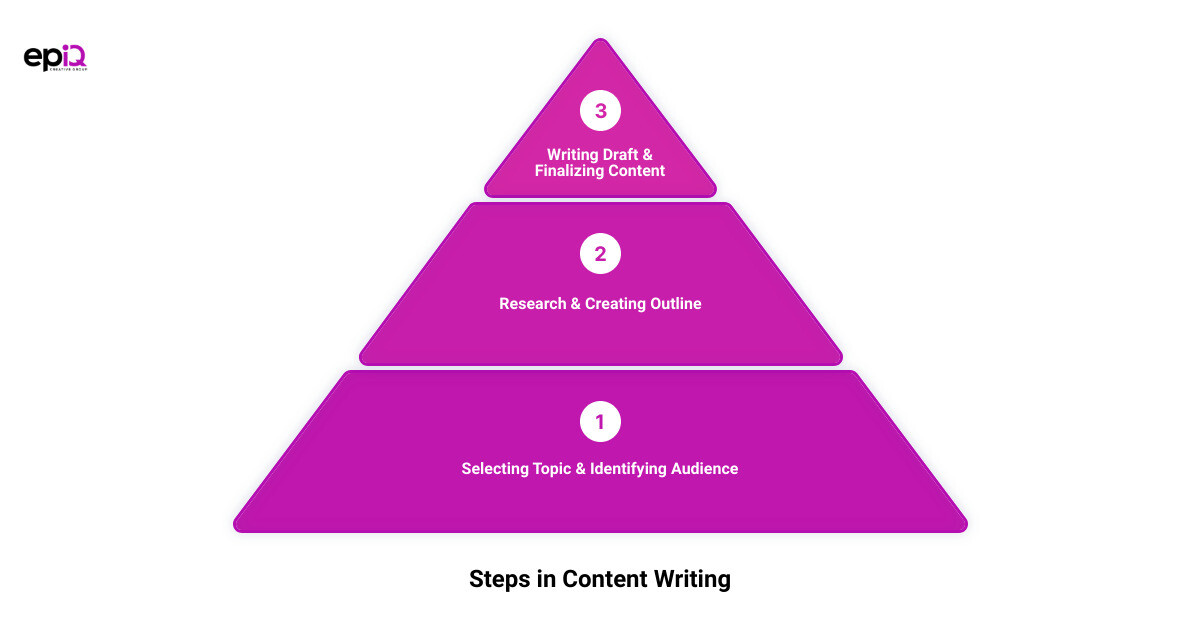Introduction: Understanding the Basics of Article and Content Writing
In today’s digital marketing landscape, article and content writing play a significant role in shaping a brand’s online presence. But what exactly is article and content writing and why does it matter for businesses like those in the epIQ Creative Group‘s client avatar?
At its core, content writing is the process of planning, crafting, and refining web copy, typically for digital marketing purposes. It creates value for a specific audience by addressing their unique needs and challenges, establishing a relationship of trust – a crucial factor in building a brand. Content writing encompasses various formats, including blog posts, articles, scripts for videos and podcasts, and even social media content.
On the other hand, article writing, a subdomain of content writing, primarily focuses on creating comprehensive and informative pieces on specific topics. It’s about providing readers with valuable insights while maintaining an engaging and relatable tone.
Whether you’re a professional in a leadership role, managing marketing and brand promotion, or someone seeking to elevate your brand through engaging content, understanding the basics of article and content writing can be a game-changer. This guide will clarify the distinction between article writing and content writing, walk you through the content writing process, share insights on creating engaging content, and highlight some of the best tools for content writers. The journey to mastering the art of crafting engaging and effective content starts here!

The Distinction Between Article Writing and Content Writing
The world of writing is as diverse as it is expansive. For an untrained eye, it might all look the same. However, there’s a subtle yet significant difference between article writing and content writing that every writer and marketer should understand.
Defining Article Writing: Its Purpose and Key Aspects
Article writing can be likened to a deep dive into a specific topic. It’s a form of writing that focuses on creating informative, well-researched pieces for various mediums, including newspapers, magazines, journals, and online publications.
Articles typically have a longer format and delve deep into a subject matter, providing in-depth analysis, insights, facts, and statistics to educate the readers.
Key aspects of article writing include:
- Research and Analysis: Article writers conduct rigorous research to gather accurate and credible information, statistics, and expert opinions to support their content.
- Structure and Flow: Articles follow a defined structure, including an introduction, body paragraphs with supporting evidence, and a conclusion, providing a coherent flow of information.
- Citations and References: To ensure credibility, articles often include citations and references to acknowledge the sources used.
- Objective Presentation: Article writers strive to maintain objectivity while presenting information and avoid personal biases or opinions.
- Targeted Publications: Content is tailored to specific publications, adhering to their guidelines, and meeting their readers’ expectations.
Defining Content Writing: Its Purpose and Key Aspects
Content writing, on the other hand, is a broad term that encompasses the creation of various forms of written material designed to engage and inform the target audience. This includes written content for websites, blogs, social media platforms, marketing campaigns, and more.
The ultimate goal of content writing is to deliver valuable information in a way that captures attention, engages the audience, and encourages them to take action.
Key aspects of content writing include:
- Versatility: Content writing covers a wide range of formats such as blog posts, social media updates, website copy, email newsletters, and product descriptions.
- Audience Engagement: Content writers aim to connect with the target audience by producing engaging and relatable content that addresses their needs and interests.
- SEO Optimization: Content writers often incorporate search engine optimization (SEO) techniques to ensure their content ranks well in search engine results and attracts organic traffic.
- Brand Consistency: Content writers work closely with the brand’s voice and tone guidelines to maintain consistency across all written materials.
- Call-to-Action (CTA): Content writing often includes persuasive CTAs to encourage readers to take a specific action, such as making a purchase, subscribing, or sharing the content.
The Overlapping Skills Required in Both Article and Content Writing
Although content writing and article writing have distinct characteristics, they also share some overlapping skills. Both require excellent writing skills, research abilities, and a solid understanding of the target audience. In addition, both types of writing demand the ability to convey complex information in an easy-to-understand, engaging manner.
Whether you’re crafting a compelling blog post or an informative article, the power of your writing lies in your ability to connect with your audience, provide valuable information, and inspire action. Understanding the nuances between content writing and article writing can help you better leverage these skills and create effective written content for your brand.

The Process of Content Writing: A Step-by-Step Guide
Diving headfirst into content writing can seem daunting, but fear not! By breaking down the process into manageable steps, you can create engaging and effective content that resonates with your audience. Here are the critical stages you need to follow:
Selecting a Topic and Identifying Your Target Audience
Before you even put pen to paper, you need to understand who you’re writing for and what interests them. This involves clearly defining your target audience and understanding their demographics, interests, and challenges. Once you’ve defined your audience, selecting a topic becomes easier. Choose topics that not only interest you but also provide value to your audience and solve their problems.
Researching and Gathering Facts
Once you’ve chosen a topic, it’s time for research. This involves diving deep into the subject matter and gathering information from reliable sources. Staying updated with the latest trends and developments in your field helps provide accurate and relevant content to your readers. Remember, your content’s value lies not only in its originality but also in its accuracy and reliability.
Creating an Outline for Your Content
After your research, it’s time to create an outline for your content. This is a critical step that helps organize your thoughts and ensures you cover all relevant points. An outline also aids in maintaining a logical flow in your content, thus making it more engaging and easy to consume. You can use templates, previous successful content, or top-performing content as a basis for your outline.
Writing a Draft and Refining Your Outline
Now comes the fun part – writing! With your outline as a guide, you can start crafting your content. Don’t fret over perfection in this stage; focus on getting your ideas down. After writing, go back to refine your outline and make sure your content hits all the major points you set out to cover.
Finalizing Your Content: Proofreading and Editing
Last but not least, proofread and edit your work. This is where you check for grammar, spelling, and punctuation errors. It’s also a good time to ensure your content is concise, clear, and free of jargon that might confuse your audience.
So, there you have it – a step-by-step guide to the content writing process. Remember, content writing is a skill that requires practice and patience. Don’t be discouraged if your first few attempts don’t turn out as expected. Keep refining your process, and you’ll eventually craft content that not only engages your audience but also drives your brand’s success.
The Art of Writing Engaging Content
In the digital world, where every scroll presents new content, ensuring that your work stands out can be a daunting task. However, with the right approach, you can craft content that not only grabs attention but also encourages interaction and fosters trust among your audience. Let’s dive in and explore the art of writing engaging content.
Crafting Magnetic Headlines and Introductions
In the world of content marketing, it can take just 15 seconds for a visitor to decide whether your content is worth their time. With such a short window to capture attention, crafting powerful headlines and introductions is paramount. According to a study of 900 million articles, headlines between 14-17 words perform best in terms of shares. Adding an emotional element to your titles can further enhance their impact. Tools like Emotional Marketing Value can help you gauge the emotional impact of your copy.
When it comes to introductions, brevity is key. Aim for an introduction that is 4-8 sentences long and avoid unnecessary fluff. Use this space to preview your content, highlighting the benefit of reading further rather than simply listing topics.
Making Your Content Easy to Consume and Share
In this era of information overload, content needs to be easily digestible. Break down complex concepts into easy-to-understand parts. Use subheadings, bullet points, and short paragraphs to enhance readability. Additionally, incorporating shareable snippets, like quotes or facts, can encourage readers to share your content on social media. Remember to have these snippets ready before you publish your post and highlight them within your content.
Choosing Interesting Angles and Making Content Actionable
With millions of blog posts published daily, your content needs a compelling angle to stand out. This could be a personal story, a controversial viewpoint, or a unique design. The right angle depends on your target audience and the message you want to convey.
Beyond being interesting, your content needs to be actionable. Include step-by-step processes, real-life examples, and up-to-date information. This not only provides value to your readers but also encourages them to engage with your content.
Establishing Trustworthiness in Your Writing
Trust is a key component of content engagement. Ensure your content is trustworthy by adhering to proper grammar, backing up your arguments with research, and sharing first-hand experiences. Tools like Hemingway Editor and Grammarly can help improve your writing skills, while personal anecdotes can add authenticity to your content. Remember, in content writing, your credibility is as important as the quality of your content.
In conclusion, writing engaging content is both an art and a science. It requires creativity to capture attention, precision to provide value, and authenticity to build trust. Most importantly, it requires a keen understanding of your audience, their needs, and their interests. So, put on your creative hat and start crafting content that resonates with your audience!

Tools and Resources for Effective Content Writing
Writing content that captures attention, provides value, and builds trust can be a challenging task. Fortunately, there are a host of tools and resources available that can streamline the writing process and enhance the quality of your content. From optimizing your text for search engines to ensuring top-notch grammar, these tools can significantly boost your content writing game.
SEMRush Writing Assistant, Grammarly, Readable, Hemingway Editor, and Copyscape
In the realm of content writing, certain tools have proven to be invaluable for writers. Here are some of the top platforms that can help transform your writing:
SEMRush Writing Assistant: This tool is a favorite among SEO writers. Whether you’re creating a blog post, an article, or any other type of content, this assistant helps you craft SEO-friendly content. It offers suggestions to optimize your text for search engines, ensuring you also cater to your human readers.
Grammarly: Writing error-free content is a must. Grammarly is a powerful software that helps improve spelling, grammar, and punctuation, making editing your work a breeze. It even suggests style improvements, enhancing the overall readability of your content.
Readable: Regardless of the complexity of your subject matter, your writing should be accessible to all readers. Readable analyzes your text for readability, ensuring your content is easily digestible.
Hemingway Editor: Simplicity is key when it comes to effective writing. Hemingway Editor highlights areas in your content that can be simplified, helping you craft clear and concise text.
Copyscape: Last but not least, originality is crucial. Copyscape checks your content for plagiarism, ensuring your work is unique and free from duplicate content.
Additional Resources for Learning SEO Content, Evergreen Content, and Copywriting
Beyond the tools, there are a plethora of resources available for aspiring content writers to learn and hone their skills. Here are some of the top resources:
The Definitive Guide to Writing Blog Posts: This guide is a comprehensive resource for anyone looking to improve their blog writing skills. It offers tips and best practices on how to create engaging and share-worthy blog posts.
The Complete Guide to SEO Content: If you’re looking to write content that’s specifically engineered to rank in Google, this guide is for you. It offers insights on creating quality content that appeals to both search engines and users.
Evergreen Content: This resource is perfect for those looking to create content that continues to bring in traffic for years after it’s published. It guides you on how to plan and write evergreen content that remains relevant over time.
The Definitive Guide to Copywriting: Copywriting is a crucial skill in the world of content writing. This guide provides tips and insights from the world’s top copywriters, helping you write compelling copy for various platforms.
By leveraging these tools and resources, you can take your content writing to the next level, creating engaging, effective, and SEO-friendly content that resonates with your audience. Whether you’re writing for a blog, a website, or a social media platform, these resources can equip you with the skills and knowledge to excel in your content writing endeavors.

The Role of Content Writing in Marketing: A Case Study of epIQ Creative Group
Impeccable content writing is not a luxury but a necessity in the digital marketing landscape. To truly comprehend the power of quality content, let’s examine a real-world example of a company that has mastered the art of content writing and its application in marketing – the epIQ Creative Group.
How epIQ Creative Group Utilizes Content Writing in Their Marketing Strategies
epIQ Creative Group hones the power of content writing to fuel their marketing strategies. They understand that content writing is not solely about crafting engaging articles but extends to all facets of digital marketing. From product descriptions to landing pages, direct mail copy to promo blurbs onsite, they leverage content writing to create a cohesive brand narrative that resonates with their audience.
The company takes a strategic approach to content creation. They don’t just write for the sake of writing but plan, write, and edit their web content to solve specific problems for their target audience. This approach establishes trust and value, vital for brand building. By using content writing in this manner, epIQ Creative Group aligns their content marketing efforts with their overall business objectives.
But the journey doesn’t end here. They also understand the importance of repurposing content, turning a single piece of content into multiple assets that can be used across different platforms. This approach optimizes their content creation efforts and extends the reach of their content.
The Quantum Circle™ Program: A Monthly Design and Content Marketing Solution
EpIQ Creative Group has taken their commitment to quality content a step further with their Quantum Circle™ Program. This monthly design and content marketing solution is designed to help businesses elevate their brand and engage their audience.
The program leverages the power of content writing and design to create a consistent and compelling brand narrative. From crafting engaging blog posts and articles to creating eye-catching visuals, the Quantum Circle™ Program covers all aspects of content marketing.
By combining engaging content with strategic marketing, the Quantum Circle™ Program helps businesses attract their target audience, generate leads, and close deals. This comprehensive approach underscores the critical role that content writing plays in marketing and brand promotion.
In conclusion, epIQ Creative Group exemplifies how content writing can be harnessed to fuel successful marketing strategies. By creating engaging, problem-solving content and repurposing it across various platforms, the company maximizes its content creation efforts. Their Quantum Circle™ Program further illustrates how quality content writing, coupled with strategic marketing, can elevate a brand and engage its audience.
Conclusion: The Impact of Effective Article and Content Writing on Your Brand’s Success
Just as a riveting narrative can enthrall readers and keep them hooked till the end, effective article and content writing can captivate your audience and foster a deep-seated connection with your brand. However, this isn’t the end of the story. The magic of content writing extends far beyond just attracting and engaging your audience. It’s a powerful tool that, when used effectively, can skyrocket your brand’s success.
Effective content writing serves as the backbone of your digital marketing strategy. It does more than just tell a story; it provides valuable information, solves problems, and creates a sense of trust and authority around your brand. This credibility is crucial in the digital landscape where competition is fierce, and consumers are increasingly discerning about the brands they choose to engage with.
Remember, content is not just about selling, it’s about providing value. When you focus on delivering information that is helpful, relevant, and engaging, you will attract the right audience. This audience, in turn, will be more likely to become loyal customers, share your content, and advocate for your brand. This is the power of effective content writing.
Moreover, leveraging the right tools, such as SEMRush Writing Assistant, Grammarly, Readable, Hemingway Editor, and Copyscape, can drastically improve the quality of your content. They can help to ensure your writing is engaging, error-free, SEO-friendly, and unique.
Take a leaf out of epIQ Creative Group’s book; they’ve harnessed the power of content writing to drive their marketing strategies successfully. Their Quantum Circle™ Program is a shining example of how strategic marketing coupled with high-quality content can elevate a brand and engage its audience.
In conclusion, the art of crafting engaging and effective content is not just about writing well—it’s about understanding your audience, delivering value, and continuously refining your skills. The impact of this on your brand’s success can be monumental. So, whether you’re just starting out or an experienced writer, keep honing your skills, stay updated with industry trends, and never stop learning. After all, in the realm of content writing, every word counts.
